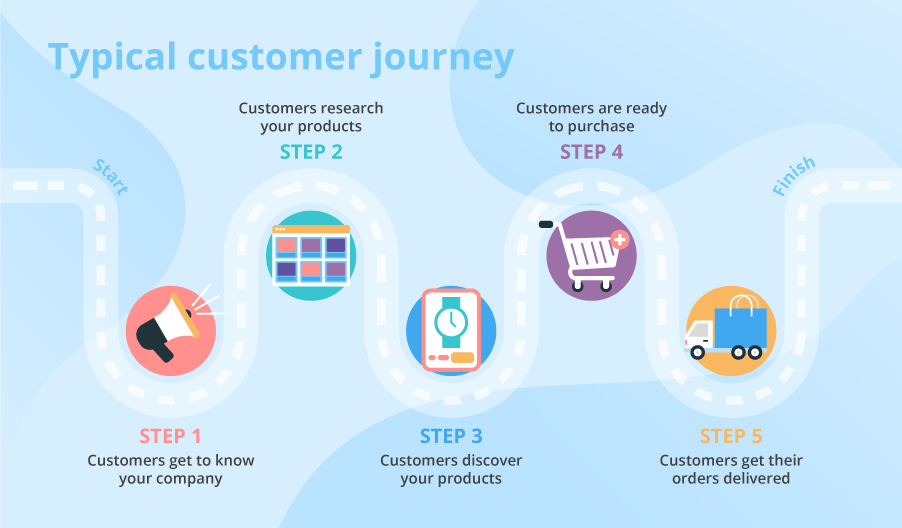Ecommerce Best Practices: Own Customer Experience within a Website and Beyond
Editor’s note: In the article, we’ll be talking about customer experience, which is an area of our particular interest. As ecommerce consultants, we make effective customer experience management the ultimate goal of our involvement. Tanya has summarized the key highlights of ScienceSoft’s approach based on 22 years of experience, not always smooth.
You probably wait for UX design tips when researching the topic of ecommerce best practices. Indeed, ecommerce success is often attributed to converting digital journeys only. In ScienceSoft, we share a different vision: a digital journey within a website doesn’t equal the overall experience customers have with your company. Even a good ecommerce website won’t blind your clients if they go through delivery or customer service issues.
Here is a real-life illustration generalized from the experience we have witnessed repeatedly. Let’s say, an ecommerce retailer struggles to add an extra delivery option – in-store pickup. Unfortunately, they don’t organize stock and order management properly and ‘welcome’ incorrect stock levels, backorders, and delayed delivery. As a result, their customers convert smoothly on the website but get the frustrating after-purchase experience and never return. This loses the business a great share of revenue, which is understandable – estimates say that the probability to buy is at least 5 times higher for a repeat customer than for a first-time visitor. With this example I conclude – business won’t succeed unless provided customer experience is good the whole way.
To help you ensure stellar end-to-end customer experience, we list 5 steps of a typical customer journey and share the experience of how we optimize them to drive customer loyalty. Some ideas are taken from our custom ecommerce development practice when business-specific solutions are needed.

Step 1. Customers get to know your company
Any successful sale starts with your future customer landing on the site, so it only seems fair for you to want to attract as many visitors as you can and immediately. But don’t rush to invest in all possible customer acquisition channels – some may turn out a money pit for your business. What helps us to assist effectively in acquisition strategy design is a target audience research. Let me share questions that ScienceSoft’s BA team asks to investigate target shoppers:
- Who are my customers (age, gender, occupation, income, etc.)?
- Where are they from (do we target the local or the international market)?
- What are their interests? Where do they spend free time?
- Are they aware of the brand?
- What other products do they buy/use?
Knowing this information, you understand what marketing channels will work out and, thus, achieve the best customer acquisition cost. You may use one or several techniques from the list:
- Search engine marketing.
- Social media marketing.
- Online advertising.
- Affiliate marketing.
- Event marketing.
- Offline advertising.
Step 2. Customers research your products
When your acquisition strategy kicked in, your goal is to prompt visitors to a shopping journey. At this step, the risk is a one-page session when your visitors don’t interact with page elements and other pages. I make practical recommendations out of our experience in fighting a high bounce rate and creating smooth website journeys.
- Don’t save on professional UI design. The troubling statistics says that the average bounce rate in online retail exceeds 45% - if iterated, about half of your visitors are ready to abandon the website after a single page. Poor visual impression can be one of the abandonment reasons as it entails a visitor’s instant mistrust of the company as a whole. The best practices of web design demand an ecommerce website to be visually and emotionally appealing. For that, ScienceSoft’s ecommerce designers aim for simplicity and brand consistency balanced with the latest UI design trends: digital illustrations, 3D animation, full-screen background images, video content, overlaying animation and more.
- Organize your supply planning effectively. Here, we deal with the business process that goes behind-the-scenes but affects customer experience directly. Seeing that the product they are interested in is out of stock is disappointing for your clients. When the experience repeats, they find it easier to buy it from another seller. At ScienceSoft, we solve this problem by implementing a data analytics solution with predictive modeling. Here is an illustrative example from our practice – a manufacturer relies on our data science solution to trace sales trends, forecast sales and plan supply more accurately.
- Enhance search capabilities. To achieve converting shopping journeys, you should give visitors a chance to browse through your catalog, however large it is. But keep in mind that they don’t want to put in the hours on such an activity. Therefore, the more search assistance you provide, the more chances are that they will find something to buy. Among the best practices we always apply are user-friendly navigation design, tailored filtering system based on the attributes of your product range, a flexible search engine and custom product collections (the criteria for grouping are specific for each product line and target audience).
Step 3. Customers discover your products
We move on to a product page where we must turn visitors’ current interest into a purchasing intent.
- Make informative product pages. Ecommerce allows for a more informed product choice, but only in case you’ve put your mind to create a strong product presentation. Think of all the information that an accredited sales consultant could tell about your products to encourage a buy – and put it on a product page. Your investments might encompass unique content creation, professional product photography and some coding. For example, our clients entrust us with page design and front-end development, integration of a robust content management system, social media integration, implementation of a custom product builder, and much more.
- Inform about delivery terms. Extra cost for delivery added at the checkout is one of the reasons for checkout abandonment. According to the UX best practices, we always recommend outlining your delivery terms (cost and timeframes) on the stage of product research, rather than purchase.
- Map diverse customer journeys. Adding a product to the shopping cart is only one of the ways how a customer journey may unfold. By enabling a possibility to compare products or save them for later in a wish list, you interact effectively with those visitors who don’t have an immediate intent to buy.
Step 4. Customers are ready to purchase
A customer’s digital journey ends up in a purchase if the checkout experience is smooth. No wonder that checkout best practices are widely discussed among ecommerce practitioners. We find it important to impart our team’s expertise as well and refer you to our comprehensive checkout optimization guide. There, we investigated in detail the reasons prompting shoppers to leave the website when they are one step away from a purchase, and elaborated solutions.
Step 5. Customers get their orders delivered
From online shopping, customers expect omnichannel delivery options and several delivery timeframes to choose from. When the task is to organize a seamless order management process for an ecommerce or omnichannel retail company, ScienceSoft opts for implementing an ERP system. Integrated with your sales channels and shipment carriers, it allows processing orders from your online and offline sources, routing orders to multiple warehouses, tracking shipments and automating order status notifications. We always feel responsible for the choice of technologies to digitize business processes of our clients. Once at a loss as for what ERP software to offer, we made our decision fact-based. We researched the global ERP software market and decided on Microsoft Dynamics 365 and Acumatica as the ERP products best-suited for ecommerce and omnichannel retail businesses.
Only a holistic approach works
First of all, effective customer experience management is a strategy. Aiming your efforts at applying minor changes here and there will not bring substantial results. Only a holistic approach covering the whole customer journey, from brand awareness to loyalty, works.
I know how busy managers in ecommerce are with daily marketing, sales, customer service, procurement tasks that cannot wait. That’s why it’s often very difficult to oversee and drive customer experience in-house. Our ecommerce team loves to help businesses introduce customer experience management and increase sales as a result. ScienceSoft is not the only ecommerce consultancy but one of a few that covers the entire customer experience, not only its digital part. If that sounds like something you need, we are happy to help.

